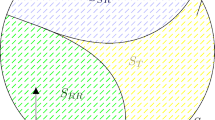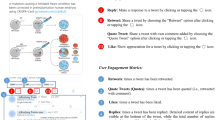Abstract
This paper investigates how and why scientific video articles are communicated on Twitter. We use video articles published in the Journal of Visualized Experiments (JoVE) as our objects of study. We harvested tweets from October 2011 to November 2015 that contained one or more JoVE links. These tweets “citing” JoVE articles were analyzed both statistically and qualitatively. In this paper, we present the distribution of these tweets, with a closer look at the affordance use of Twitter including hashtags and mentions. In addition, we conducted a content analysis of the sampled Twitter accounts and tweets. We present the coding schemes and results of both Twitter user accounts and tweets text. In addition to the analysis of the coding results, we discuss the content of the tweets with particular attention to issues including the video/visual feature mentioned, the role of Twitter bots, and self-promotion of different stakeholders in the Twitter communication of JoVE video publications.

Similar content being viewed by others
References
Brook, J. (2011). The affordances of YouTube for language learning and teaching. Hawaii Pacific University TESOL Working Paper Series, 9(1–2), 37–56.
Cayar, C. (2011). The YouTube effect: How YouTube has provided new ways to consume, create, and share music. International Journal of Education & the Arts, 12(6). Retrieved September 1, 2017, from http://www.ijea.org/v12n6/.
Clifton, A., & Mann, C. (2011). Can YouTube enhance student nurse learning? Nurse Education Today, 31(4), 311–313.
Eriksson-Backa, K., Holmberg, K., & Ek, S. (2016). Communicating diabetes and diets on Twitter—A semantic content analysis. International Journal of Networking and Virtual Organisations, 16(1), 8–24.
Fernandez, V., Simo, P., Algaba, I., Albareda-Sambola, M., Salan, N., Amante, B., et al. (2011). “Low-cost educational videos” for engineering students: A new concept based on video streaming and YouTube channels. International Journal of Engineering Education, 27(3, Pt. 1), 518–527.
Franz, K. (2012). Organic chemistry YouTube writing assignment for large lecture classes. Journal of Chemical Education, 89(4), 497–501.
Haustein, S., Bowman, T. D., Holmberg, K., Tsou, A., Sugimoto, C. R., & Larivière, V. (2016). Tweets as impact indicators: Examining the implications of automated “bot” accounts on Twitter. Journal of the Association for Information Science and Technology, 67(1), 232–238.
Haustein, S., & Costas, R. (2015). Identifying Twitter audiences: Who is tweeting about scientific papers. ASIS&T SIG/MET workshop, 2015.
Haustein, S., Costas, R., & Larivière, V. (2015). Characterizing social media metrics of scholarly papers: The effect of document properties and collaboration patterns. PLoS ONE, 10(3), e0120495.
Holmberg, K., Bowman, T. D., Haustein, S., & Peters, I. (2014). Astrophysicists’ conversational connections on Twitter. PLoS ONE, 9(8), e106086.
Holmberg, K., & Thelwall, M. (2014). Disciplinary differences in Twitter scholarly communication. Scientometrics, 101(2), 1027–1042.
Hoskins, D. (2009). “Do you YouTube?” Using online videos in women’s studies courses. Feminist Collections: A Quarterly of Women’s Studies Resources, 30(2), 15–17.
Jones, T., & Cuthrell, K. (2011). YouTube: Educational potentials and pitfalls. Computers in the Schools, 28(1), 75–85.
JoVE. (2017). About JoVE. Retrieved September 1, 2017, from https://www.jove.com/about.
Kaw, A., & Garapati, S. (2011). Development and assessment of digital audiovisual Youtube lectures for an engineering course in numerical methods. Computers in Education Journal, 21(2), 89–97.
Knösel, M., Jung, K., & Bleckmann, A. (2011). YouTube, dentistry, and dental education. Journal of Dental Education, 75(12), 1558–1568.
Kousha, K., Thelwall, M., & Abdoli, M. (2012). The role of online videos in research communication: A content analysis of YouTube videos cited in academic publications. Journal of the American Society for Information Science and Technology, 63(9), 1710–1727.
Muniandy, B., & Veloo, S. (2011). Managing and utilizing online video clips for teaching English language: Views of TESOL pre-service teachers. In Proceedings of the second international conference on education and management technology (IPCSIT) (Vol. 13, pp. 173–178).
Pasquali, M. (2007). Video in science. EMBO Reports, 8(8), 712–716.
Priem, J., & Costello, K. L. (2010). How and why scholars cite on Twitter. Proceedings of the American Society for Information Science and Technology, 47(1), 1–4.
Rees, J. (2008). Teaching history with YouTube. Perspectives on History, 46(5). Retrieved September 1, 2017, from http://www.historians.org/Perspectives/issues/2008/0805/0805tec2.cfm.
Settle, Q., Telg, R., Irani, T., Baker, L., Rhoades, E., & Rutherford, T. (2011). Instructors’ social media use and preferences in agriculture classes. North American Colleges and Teachers of Agriculture Journal, 52(2), 78–83.
Thelwall, M., Haustein, S., Larivière, V., & Sugimoto, C. R. (2013). Do altmetrics work? Twitter and ten other social web services. PLoS ONE, 8(5), e64841.
Tsou, A., Bowman, T. D., Ghazinejad, A., & Sugimoto, C. R. (2015). Who tweets about science? In ISSI.
Vainio, J., & Holmberg, K. (2017). Highly tweeted science articles: who tweets them? An analysis of Twitter user profile descriptions. Scientometrics, 122(1), 345–366.
Van Noorden, R. (2014). Online collaboration: Scientists and the social network. Nature, 512(7513), 126–129.
Xu, S., Yu, H., Hemminger, B. M., Dong, X. (2017). Communicating scientific video articles on Twitter: An initial exploration of JoVE publications. In Proceedings of ISSI 2017—The 16th international conference on scientometrics and informetrics (pp. 442–447). China: Wuhan University.
Yu, H., Xu, S., Xiao, T., Hemminger, B. M., & Yang, S. (2017). Global science discussed in local altmetrics: Weibo and its comparison with Twitter. Journal of Informetrics, 11(2), 466–482.
Acknowledgements
The present study is an extended version of an article (Xu et al. 2017) presented at the 16th International Conference on Scientometrics and Informetrics, Wuhan (China), 16–20 October 2017. The authors would like to thank Altmetric.com for supplying the data and its descriptions for our study. The authors would like to thank Huan Lian for helping with the initial step of the content analysis. The authors would like to thank Debbie Maron, Austin Ward, and Sandeep Avula for providing suggestions in writing the paper. The authors would like to thank the reviewers of this article for their valuable suggestions.
Author information
Authors and Affiliations
Corresponding author
Rights and permissions
About this article
Cite this article
Xu, S., Yu, H., Hemminger, B.M. et al. Who, what, why? An exploration of JoVE scientific video publications in tweets. Scientometrics 117, 845–856 (2018). https://doi.org/10.1007/s11192-018-2880-x
Received:
Published:
Issue Date:
DOI: https://doi.org/10.1007/s11192-018-2880-x




